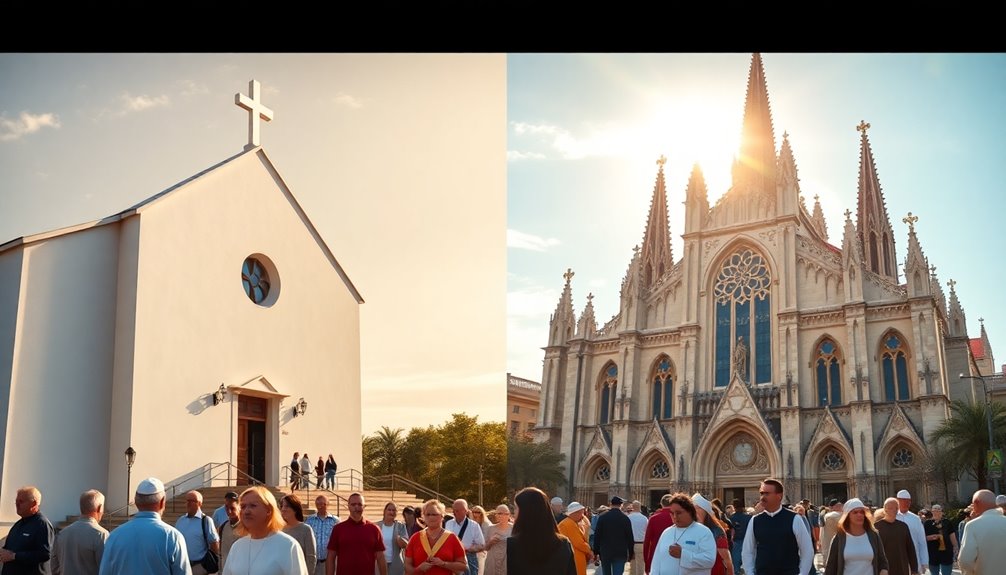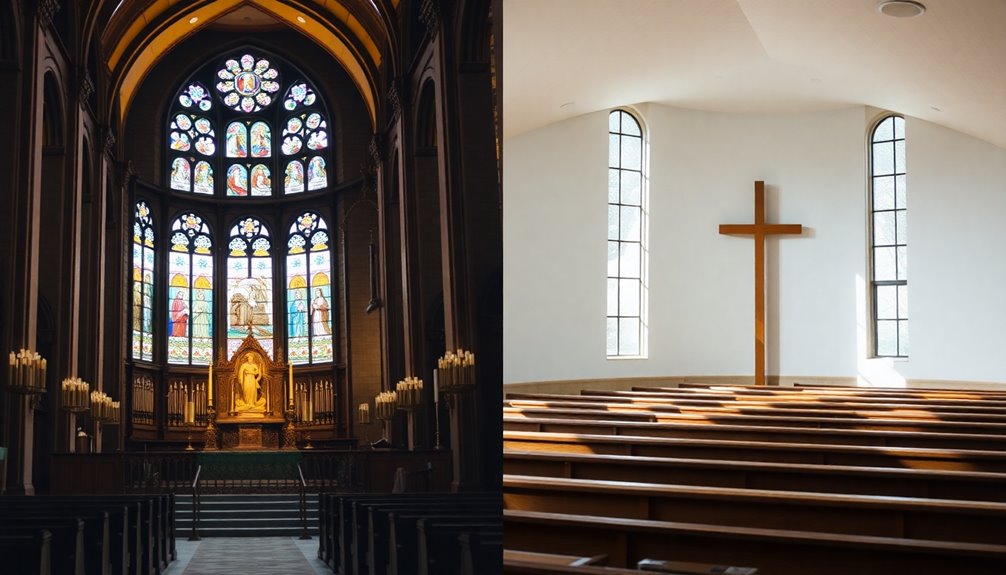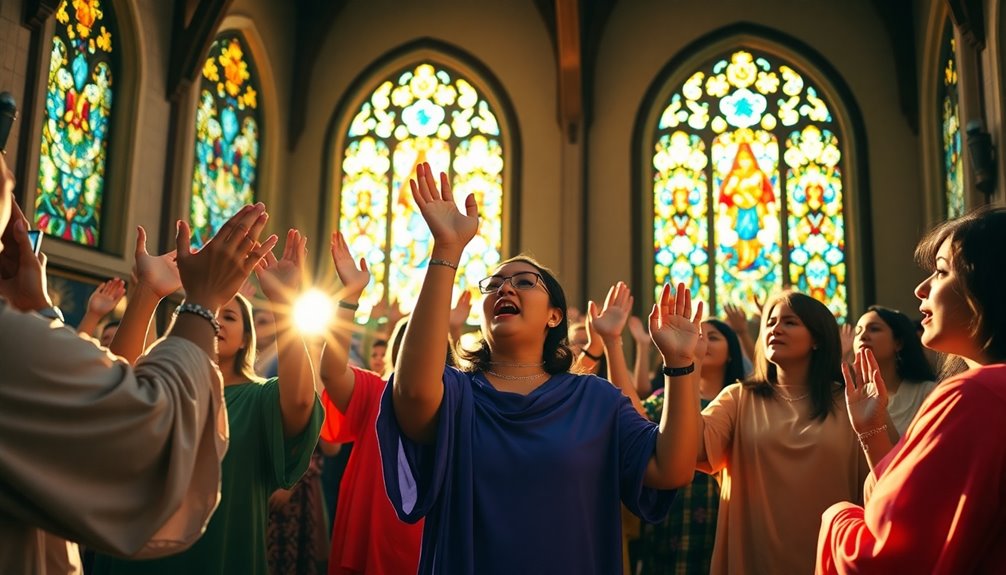Protestants and Catholics are two major branches of Christianity, each with distinct beliefs and practices. Catholics emphasize tradition, the authority of the Pope, and the importance of good works for salvation. In contrast, Protestants prioritize the Bible as the sole authority and believe salvation comes through faith alone. While Catholics engage in structured prayers and sacramental practices, Protestants often favor individual, spontaneous expressions of faith. Historical conflicts have influenced both traditions, shaping their identities. If you're curious about the deeper nuances in their beliefs and practices, there's much more to discover about these rich traditions.
Key Takeaways
- Branches of Christianity: Christianity primarily consists of Catholicism, the oldest denomination, and Protestantism, which emerged from the Reformation in the 16th century.
- Salvation Views: Catholics believe salvation involves faith, good works, and sacraments, while Protestants emphasize justification by faith alone (*sola fide*).
- Authority Sources: Catholics uphold both scripture and sacred tradition as authoritative, whereas Protestants adhere to *sola scriptura*, viewing the Bible as the sole authority.
- Eucharist Understanding: Catholics practice transubstantiation in the Eucharist, while Protestants typically view it as symbolic or memorial in nature.
- Role of Saints: Catholics venerate saints and seek their intercession, whereas Protestants assert direct access to God without intercessors.
Introduction
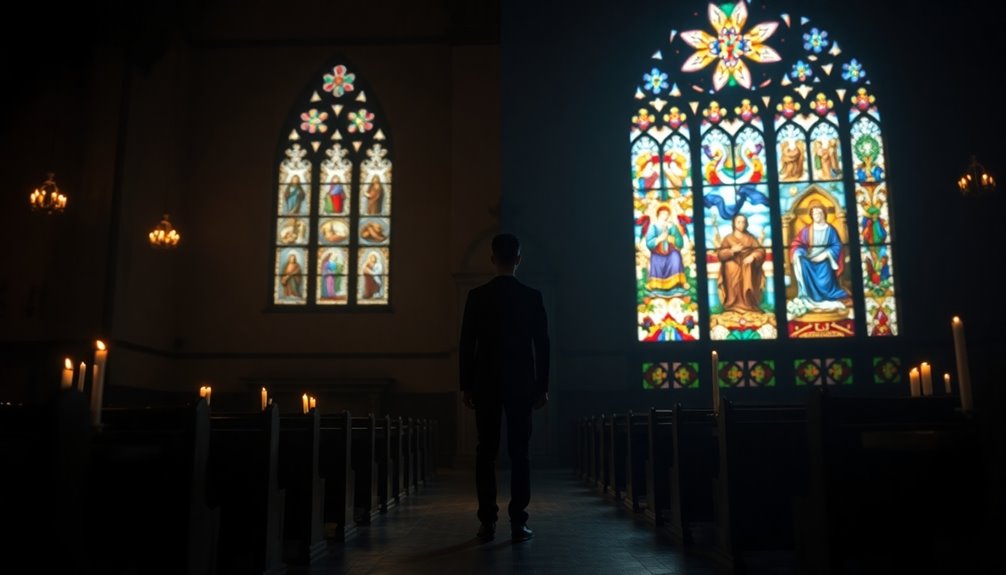
When you delve into the world of Christianity, you'll find it primarily divided into two major branches: Catholicism and Protestantism. Catholicism, with over 1 billion followers, is the oldest Christian denomination, having separated from the Eastern Orthodox Church in 1054. On the other hand, Protestantism emerged from the Reformation, sparked by Martin Luther's 95 Theses in 1517, and encompasses around 900 million adherents.
At the heart of these two branches are key theological differences. Catholics believe in the authority of the Pope and the doctrine of transubstantiation, which teaches that bread and wine become the actual body and blood of Christ during the Eucharist. Protestants, however, emphasize sola scriptura and sola fide, asserting that scripture alone guides their beliefs and that faith alone is sufficient for salvation.
Worship practices also differ significantly. Catholic services are structured around the liturgical life, focusing on the Eucharist, while Protestant gatherings often prioritize personal faith and Bible study in varied settings.
Despite their differences, ongoing dialogue between Catholics and Protestants aims to bridge these theological divides, reflecting the rich complexity and diversity within Christianity.
Biblical Authority and Interpretation
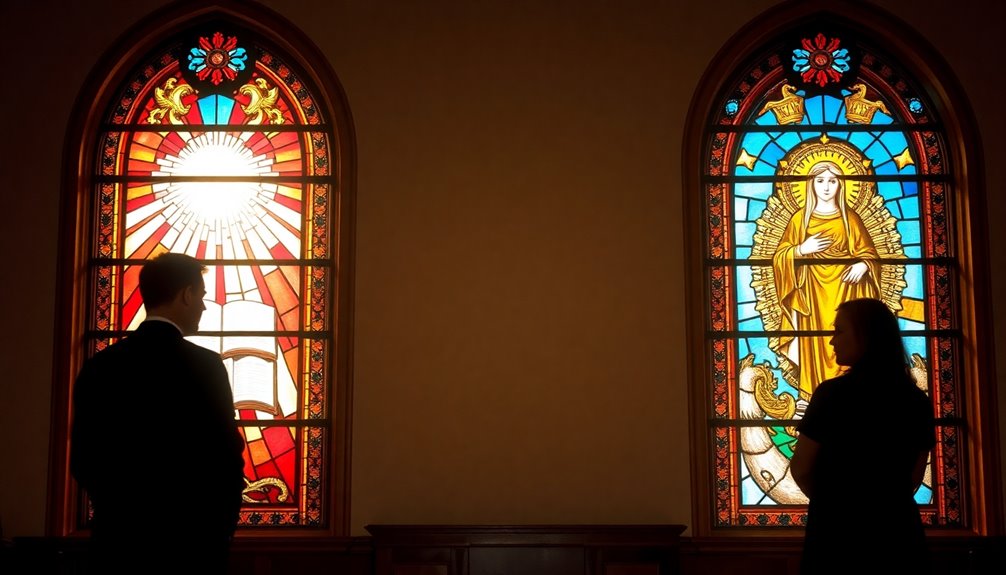
When you look at how Protestants and Catholics approach the Bible, you'll notice some key differences.
Protestants often focus on primary Bible references for guidance, believing in personal interpretation, while Catholics rely on both primary and secondary references, with the Church's teachings playing a crucial role.
This distinction shapes their understanding of faith, tradition, and the path to salvation.
Primary Bible References
Understanding the primary Bible references that shape Protestant and Catholic beliefs reveals significant differences in biblical authority and interpretation.
Protestants hold firmly to sola scriptura, which means they view the Bible alone as the sole authority for faith and practice. This stance is supported by verses like 2 Timothy 3:16, which highlights the inspiration and sufficiency of Scripture.
In contrast, Catholics believe in the dual authority of scripture and sacred tradition, leading to many Catholic doctrines that don't stem directly from the Bible.
You might notice that Protestants advocate for individual interpretation of Scripture, guided by the Holy Spirit, while Catholics maintain that only the Church can accurately interpret biblical texts. This belief is rooted in the idea that the Church's teachings are divinely protected from error, a significant divergence from the Protestant perspective that acknowledges potential errors in church teachings.
These contrasting views on the authority of scripture and interpretation underpin many theological disagreements between Protestantism and Catholicism, deeply influencing their understandings of salvation and grace, especially in light of the Protestant Reformation.
Secondary Bible References
The debate over biblical authority and interpretation between Protestants and Catholics extends beyond primary references, delving into secondary Bible references that illustrate their distinct theological frameworks. For you, understanding these differences is key.
Protestants adhere to the principle of sola scriptura, viewing the Bible as the sole authority of Scripture. They believe that every doctrine should stem from Scripture alone, as highlighted in 2 Timothy 3:16. This leads to a more personal interpretation of the Bible, guided by the Holy Spirit.
In contrast, Catholic beliefs maintain that both the Bible and sacred tradition hold equal authority. This means that many Catholic doctrines, such as purgatory and prayers to saints, derive from tradition rather than explicit scriptural evidence.
You'll find that the Catholic Church asserts its infallibility in interpreting Scripture, claiming that only it can provide accurate understanding. This fundamental difference shapes how each tradition approaches salvation, particularly regarding grace alone and the role of the church in one's faith journey.
The varying interpretations and authoritative claims result in significant theological disagreements that continue to resonate today within Protestant churches and Catholic communities alike.
Reformation's Impact on Europe
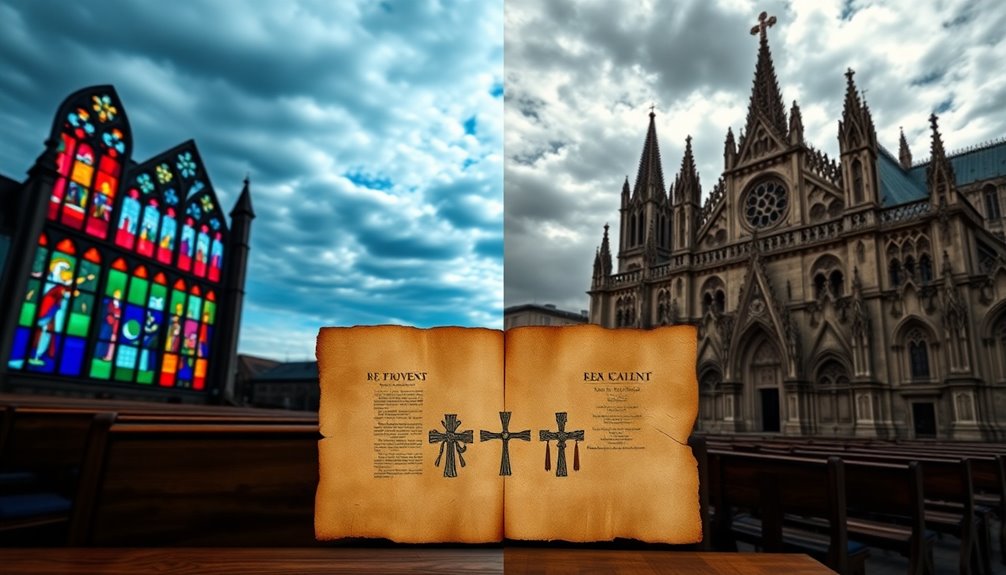
Across Europe, the Protestant Reformation sparked profound changes that reshaped religious, political, and social landscapes. Initiated by Martin Luther in 1517, this movement challenged the authority of the Catholic Church and led to the establishment of various Protestant denominations, including Lutheranism and Calvinism.
As these denominations spread rapidly across regions like Germany, Switzerland, and England, the Catholic Church found itself responding through the Counter-Reformation. The Council of Trent (1545-1563) was a crucial part of this response, reaffirming Catholic doctrines while attempting to reform clerical practices.
The Reformation significantly altered the religious landscape of Europe, contributing to a decline in Catholic political power as many nations embraced Protestantism. This shift not only led to major conflicts like the Thirty Years' War but also fostered a culture of individual interpretation of Scripture.
As a result, literacy and education flourished, influencing European culture and society for centuries to come. By challenging traditional structures, the Protestant Reformation set the stage for modernity, encouraging individuals to think critically about faith and authority, a legacy that continues to resonate today.
Historical Contextual Analysis

While examining the historical context of the Protestant Reformation, it's essential to recognize how deeply rooted the tensions between Protestantism and Catholicism are in European history.
The Reformation began in 1517 when Martin Luther published his 95 Theses, directly challenging the practices and authority of the Catholic Church. This pivotal moment marked the rise of Protestants, who sought to address perceived corruption within Catholicism, particularly regarding the sale of indulgences.
The Catholic Church, having split from the Eastern Orthodox Church in 1054, maintained a hierarchical structure centered around the Pope. In reaction to the Reformation, the Council of Trent (1545-1563) emerged as a crucial response, reaffirming Catholic doctrines while attempting to address some concerns raised by Protestant reformers.
These theological disputes led to significant historical conflicts, including the Thirty Years' War, which reshaped European politics and society.
The resulting divisions forged a landscape where Catholics and Protestants coexist, yet often remain at odds, highlighting the lasting impact of the Reformation on religious and cultural identities across Europe.
Misunderstanding Salvation's Role
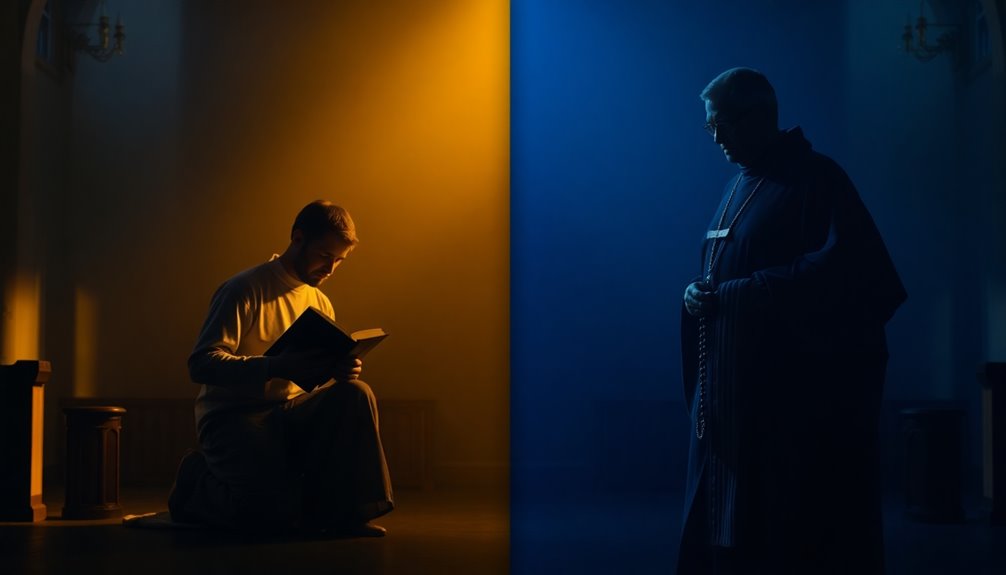
When you explore salvation in Protestant and Catholic beliefs, you'll notice significant misconceptions about its role.
Many people misinterpret how faith practices shape each tradition's view on salvation.
Understanding these differences can clarify why each side emphasizes faith and works in unique ways.
Address Misconceptions About Salvation
Many people misunderstand the role of salvation in Protestant and Catholic beliefs, often oversimplifying complex theological concepts.
Catholics view salvation as a process, intertwining faith, good works, and participation in the sacraments. They believe justification isn't just a one-time act but an ongoing journey, where individuals continually grow in grace.
In contrast, Protestants embrace *sola fide*, believing that faith alone in Christ is sufficient for salvation. For them, justification is a singular moment where one is declared righteous before God.
This difference leads to varying views on good works. Catholics see them as essential for receiving grace, while Protestants view good works as a natural outcome of genuine faith rather than a requirement.
Additionally, the belief in purgatory as a necessary step for purification before entering heaven is a significant point of divergence; Protestants reject this, asserting that justified believers go directly into God's presence upon death.
These theological distinctions around salvation shape worship practices, with Catholics emphasizing the Eucharist as central to salvation, while Protestants often see it as a symbolic act of remembrance.
Understanding these nuances helps clarify the rich tapestry of Christian belief.
Misinterpretation of Faith Practices
Misinterpretation of faith practices often stems from the differing beliefs about salvation between Catholics and Protestants. Catholics teach that faith must be accompanied by works and the sacraments for justification, viewing them as necessary steps toward salvation.
On the other hand, Protestants assert that salvation comes through faith alone (sola fide), believing that justification is a single act where God declares you righteous solely based on your faith.
This fundamental difference can lead to misconceptions. For instance, Catholics emphasize the importance of meritorious works, which can imply that salvation is earned. In contrast, Protestants see good works as the natural result of authentic faith, not a means to achieve salvation.
This distinction is crucial in understanding how each tradition approaches the concept of grace.
Additionally, the Catholic belief in purgatory further complicates matters, as Protestants often misunderstand this as suggesting that believers must atone for their sins before entering heaven.
Ultimately, recognizing these differences can help clarify the misinterpretations surrounding faith practices and the role of salvation in both traditions, fostering a deeper respect for each other's beliefs.
Faith in Daily Life
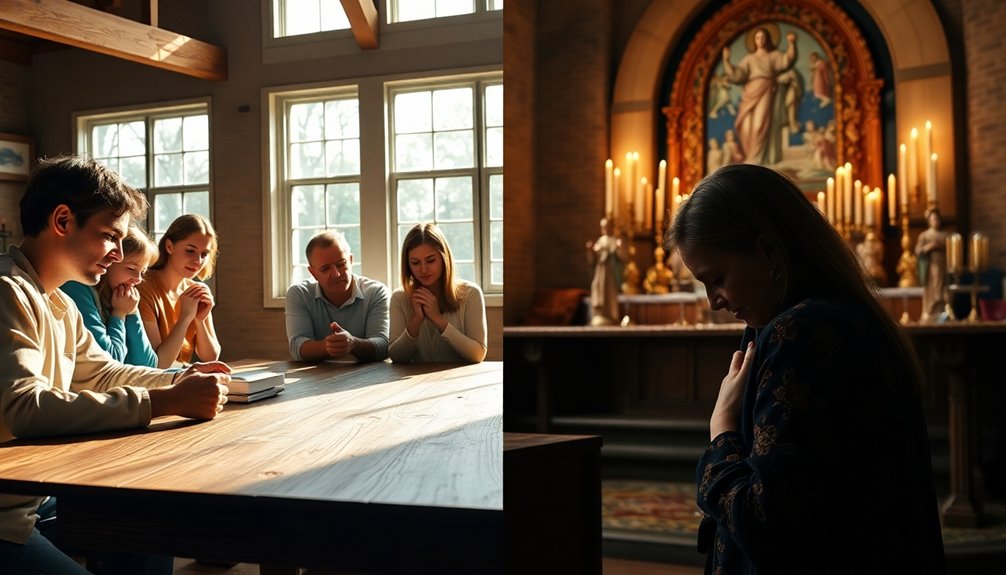
In your daily life, how you practice faith can vary significantly between Protestant and Catholic traditions.
While Catholics might prioritize daily prayers and the sacraments, Protestants often focus on personal Bible study and congregational worship.
Both approaches shape how you connect with your community and express your beliefs.
Daily Prayer Practices
Daily prayer practices play a vital role in the lives of both Catholics and Protestants, shaping how they connect with their faith. For Catholics, structured daily prayers like the Rosary and Liturgy of the Hours create a rhythm that aligns with the liturgical calendar. These prayers often include petitions for intercession from saints, emphasizing a communal aspect of faith. You might find yourself reciting set prayers that deepen your spiritual life.
On the other hand, Protestant practices vary significantly. Many Protestants focus on spontaneous, individual prayer, seeing it as a direct line to God without any intermediaries. Daily prayer often becomes a personal conversation, and you may include family devotions in this practice.
Reading Scripture also plays a central role for both traditions, enhancing your understanding and relationship with God.
While Catholics often gather for communal prayer during Mass, Protestants embrace a more diverse approach, allowing for both individual and communal prayer settings. This flexibility lets you express your faith in various ways, whether through structured prayers or heartfelt conversations with God, making daily prayer a truly personal experience.
Congregational Worship Practices
Congregational worship practices shape how you experience faith in your community, reflecting distinct traditions in both Catholicism and Protestantism.
In Catholic worship practices, the Mass is central, with the Eucharist celebrated as the real presence of Christ. This ritual emphasizes reverence and communal connection, fostering a deep sense of spiritual unity among attendees. You'll find that the structure of the service guides your experience, with prayers, hymns, and readings all leading toward the moment of communion.
On the other hand, Protestant services offer a more varied approach. They often prioritize scripture preaching and communal singing, allowing for a range of worship styles that can include contemporary music, traditional hymns, or even informal gatherings. This flexibility in worship can make your experience feel more personal and accessible.
Both traditions aim to deepen your Christian faith, yet they do so through differing emphases and rituals.
Whether you find solace in the sacredness of the Eucharist or the dynamic energy of a Protestant service, these practices ultimately nurture your spiritual growth and connection to your community.
Key Doctrinal Distinctions Highlighted
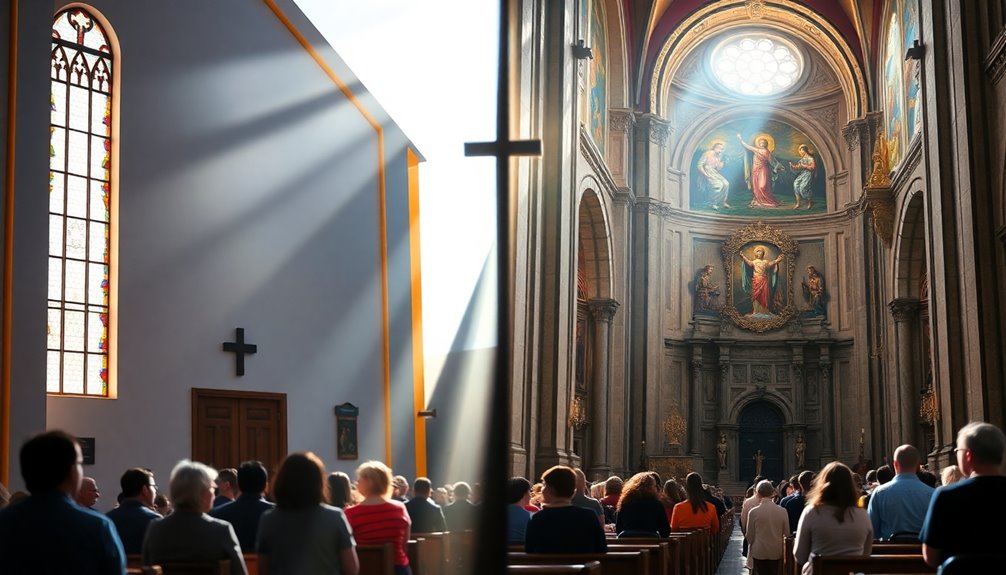
A significant number of key doctrinal distinctions separate Protestantism and Catholicism, shaping the beliefs and practices of their adherents.
One major difference lies in authority. Catholics emphasize the authority of the Pope and the Magisterium, while Protestants adhere to sola scriptura, believing Scripture alone is the ultimate authority for faith and practice.
When it comes to the Eucharist, Catholics believe in transubstantiation, meaning the bread and wine become the actual body and blood of Christ. In contrast, many Protestants view the Eucharist as symbolic or a memorial act.
Salvation is another area of divergence; Catholics teach that salvation requires faith, good works, and adherence to the sacraments, whereas Protestants advocate for sola fide, asserting that faith alone suffices for salvation.
Additionally, Catholics recognize purgatory as a necessary purification stage before entering heaven, a concept that Protestants reject, believing justified believers go directly to heaven upon death.
Lastly, while the Catholic tradition venerates saints and encourages praying to the Saints for intercession, Protestantism emphasizes direct access to God, downplaying the role of saints in your relationship with Christ.
Additional Resources

When exploring the distinctions between Protestantism and Catholicism, you'll find a wealth of resources available to deepen your understanding. Numerous books, like "Catholicism and Protestantism: A Comparison" by John Doe, provide in-depth analyses of the theological and historical differences between the two traditions.
These texts can clarify how Catholics believe in the authority of the Church alongside the Word of God, while Protestantism generally emphasizes individual interpretation and faith.
Online platforms, such as the Pew Research Center, offer comprehensive studies on the beliefs and practices of Catholics and Protestants worldwide. You can also visit the Vatican's official website, where you'll find essential documents and teachings outlining Catholic doctrine and its differences from Protestant beliefs.
Organizations like the World Council of Churches promote dialogue and understanding, offering educational programs that address both faith and practice across these traditions.
Additionally, many seminaries and theological colleges provide courses and workshops focusing on the distinctions and shared beliefs of Catholicism and Protestantism. Utilizing these resources can significantly enhance your grasp of these two rich religious traditions.
Frequently Asked Questions
What Is the Difference Between Protestant and Catholic?
When exploring differences in Christian beliefs, you'll notice varying interpretations of authority and tradition. Some emphasize a singular figure's leadership, while others advocate for individual understanding of sacred texts.
You might find distinct views on rituals, such as how bread and wine are understood during worship. Additionally, beliefs about afterlife concepts and the number of sacred practices differ significantly, influencing how communities gather and worship in their unique ways.
Is Jesus Catholic or Protestant?
You can't really categorize Jesus as either Catholic or Protestant since He lived long before those terms existed.
Jesus' teachings focus on love, compassion, and faith, transcending denominational boundaries. Both traditions see Him as the Son of God and Savior.
Instead of fitting Him into a specific label, it's more meaningful to embrace the core principles He taught and how they guide your life today, regardless of the labels that followed.
Why Did the Protestants and Catholics Fight?
You might wonder why different groups fought throughout history. Often, it's about deep-seated beliefs and practices that clash.
People have different views on authority, salvation, and how to live their faith. These disagreements can escalate into conflict, leading to wars and violence.
When you consider the impact of these divisions, it's clear that these struggles reflect not just theological differences, but also political power plays and social tensions that resonate even today.
What Do Protestants Believe?
Protestants believe that faith alone brings salvation, emphasizing a personal relationship with Jesus Christ.
They see the Bible as the ultimate authority for guidance and encourage individual interpretation through the Holy Spirit.
You'll find that they recognize only two sacraments—Baptism and Communion—viewing Communion as a symbolic act.
They embrace the idea of the priesthood of all believers, meaning you have direct access to God without needing a priest as a mediator.

